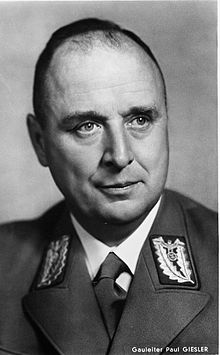Paul Giesler
Paul Giesler | |
|---|---|
 | |
| Minister President of Bavaria | |
| In office 1942–1945 | |
| Preceded by | Ludwig Siebert |
| Succeeded by | Fritz Schäffer |
| Personal details | |
| Born | 15 June 1895 Siegen |
| Died | 8 May 1945 (aged 49) Berchtesgaden |
| Nationality | German |
| Political party | Nationalsozialistische Deutsche Arbeiter Partei |
Paul Giesler (15 June 1895, Siegen, Westphalia – 8 May 1945) was a member of the NSDAP, from 1941 NSDAP Gauleiter of Westphalia-South (Westfalen-Süd) and as of 1942 also acting Gauleiter of the Gau Munich-Upper Bavaria (Gau München-Oberbayern). He was from 2 November 1942 to 28 April 1945 the Premier (Ministerpräsident) of Bavaria.
Life
The trained architect was from 1924 a Party speaker, an SA leader, and leader of an NSDAP local (Ortsgruppenleiter). During the Night of the Long Knives he only narrowly missed being arrested and murdered. He served in the Poland and France campaigns. Only from August 1941 did Giesler once again take up important Party functions, at Martin Bormann's instigation, first becoming NSDAP Gauleiter of Westphalia-South in 1941, and then as of April 1942 Adolf Wagner's successor as acting Gauleiter of Munich-Upper Bavaria. After Ludwig Siebert's death on 1 November 1942, he was also appointed acting Ministerpräsident of Bavaria. As the war continued, he took up more and more ministerial posts, especially after Wagner's death.
In Munich, Giesler was known for speaking out against higher education for women, provoking student walk-outs of his speeches. He was also known for the capture and defeat of the White Rose (Weiße Rose) student resistance movement. In April 1945, he was appointed Reich Defence Commissar-South and with help from SS units brutally quelled the "Freedom Action Bavaria" ("Freiheitsaktion Bayern") uprising under Captain Dr. Rupprecht Gerngroß in Munich. In Adolf Hitler's will of 29 April 1945, Giesler was made Reich Minister for the Interior. He never had the chance to assume this latest post, though.
As American troops approached, Giesler was reported to be planning the murder of the surviving inmates at Dachau concentration camp in March 1945. Karl von Eberstein claimed he was ordered to 'use my influence with the commander of Dachau' to have 25,000 prisoners shot when the US approached. Eberstein refused. Geisler said he would poison the prisoners. Eberstein claimed he stopped Geisler by getting an order from Himmler to simply surrender the camps. Gieseler then fired Eberstein on April 20, on orders of Martin Bormann, for 'defeatism'. [1][2] On 8 May 1945, Nazi capitulation day, Giesler and his wife committed suicide, fearing capture by American troops as they fled Berchtesgaden.
Giesler was an unquestioning follower of Hitler, ruling efficiently and with almost unlimited power in the last war years in Bavaria[3].
External links
- Detailed biography of Paul Giesler (Historisches Centrum Hagen)
- Town of Siegen: Paul Giesler's life path
- Hitler's will from 29 April 1945 (all in German)
- Picture of Paul Giesler, undated Historisches Lexikon Bayerns
Notes
Sources
- Bosl, Karl. "Paul Giesler". Bosls bayrische Biographie (in German). Universitätsbibliothek Regensburg, and Pustet. p. pages 254–255. Retrieved 2009 2 17.
{{cite web}}:|page=has extra text (help); Check date values in:|accessdate=(help) - International Military Tribunal, Trial of the Major War Criminals (5 Aug 1946). "Nuremberg Trial Proceedings Volume 20, Day 195". Avalon Project, Lillian Goldman Law Library, Yale Law School. Also William S. Hein & Co. Inc. Retrieved 2008 12 31.
{{cite web}}: Check date values in:|accessdate=(help) - Yerger, Mark C. (1997). Allgemeine-SS. The commands, units, and leaders of the General SS. Atglen, PA: Schiffer Publishing Ltd. ISBN 0764301454.
